DC’s New Wonder Woman Is a Wonder Indeed
By
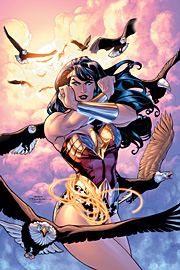 The public has seen you slice The Man of Steel’s throat on live television. They’ve seen you kill a man in order to save the lives of others. Your gods have abandoned you. Those you once counted upon as you would brothers & sisters have come to view you with a scrutinizing gaze. The world someone else has made for you is questioning your very right to exist within its’ sphere. Where do you go when everything you’ve ever known’s been called into question and taken away from you?
The public has seen you slice The Man of Steel’s throat on live television. They’ve seen you kill a man in order to save the lives of others. Your gods have abandoned you. Those you once counted upon as you would brothers & sisters have come to view you with a scrutinizing gaze. The world someone else has made for you is questioning your very right to exist within its’ sphere. Where do you go when everything you’ve ever known’s been called into question and taken away from you?
Remove yourself from the situation.
Reinforce the foundations.
Rebuild.
“One Year Later.”
That is exactly what DC Comics is doing with Wonder Woman #1, on sale now, one of the finest re-introductions of superhero iconography I’ve ever read.
Wonder Woman’s Rogue Gallery have touched down in
Writer Allan Heinberg (Young Avengers) has in twenty-plus pages, fixed what we’ve been missing for over twenty-plus years ago, turning back the clock in order to build the future. Heinberg’s Wonder Woman #1 is fat with wit, showing a genuine love for this character in all of its’ various incarnations.
It would have been very easy for artists Terry and Rachel Dodson (Spider-Man/Black Cat: The Evil That Men Do) to rest on the fact that…well…they’re The Dodsons. If one were to have a “shoot-out” involving today’s “good girl” artists, the only men left standing would be Adam Hughes, Frank Cho and of course, Terry Dodson. Fine company, for sure but with Wonder Woman #1, Terry Dodson steps out of the pack and into his own. Terry’s attention to detail is off-the-charts, reconsidering women as decidedly flat-chested and is that a statue of a Jacka on page 12?!?
Rachel continues to impress, introducing new line weights. Despite primarily inking her husband Terry, I’d say she’s become one of comics’ finest inkers.
Kudos also to colorist Alex Sinclair (Batman) for making this issue exquisite from the cover to the last page.
With gorgeous art and writing that reveres mythos while simultaneously reconsiders, Wonder Woman #1 is a testimony to the vitality of the character and the medium it represents.
RATING: 
Things Change – Big Time – This Month in “The Walking Dead”
By Mark Wheaton
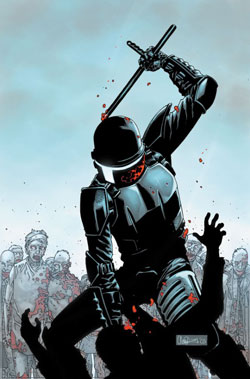 “Tell me, girl – how long do you think it would take me to ruin your life – shatter your sense of security – really fuck you up? I think a half an hour could probably do it – but really, I plan on doing this every day as often as I can, until you figure out some way to kill yourself.”
“Tell me, girl – how long do you think it would take me to ruin your life – shatter your sense of security – really fuck you up? I think a half an hour could probably do it – but really, I plan on doing this every day as often as I can, until you figure out some way to kill yourself.”
“The Walking Dead” returns to its grim-and-gory roots with a nasty issue that can’t help but change things in the book for good. Without a single intercut to see how things are going “back at the prison,” we’re shown the true depravity of the “governor,” the evil bastard who – it turns out – took the survivors from the helicopter crash and made them fight in an arena filled with zombies (yes, a’la “Land of the Dead”). His reasoning? Roman, in design – give the people bread and circuses and they won’t revolt.
How does this affect our heroes? Terribly. Though Michonne gets in a good lick of her own by tearing off someone’s ear, the last we see of her in this issue puts her in a really, really bad place. But the permanent damage is done to Rick as the governor uses a kitchen knife to cut off his hand Luke Skywalker-style, severing it at the wrist so that when he wakes up at the end of the book, all he has is a stub.
And, well, the waiting gladiatorial arena.
This is likely what the readers of “Walking Dead” have been waiting for – a return to the exploration of the world around them. While yes, developing the character relationships in the prison has done wonders to solidify our group of heroes, the lingering question will always be, “So, what else is going on?”
And now we know. “The Lord of the Flies” is in full swing and humanity has quickly gone feral, tossing aside any hint of civilization for a chance at mere survival – letting the generation who knew any other way to live die out and be replaced by the next ones who won’t know what they’re missing and can easier adapt.
It’s felt like “The Walking Dead” has been locked in a time bubble for awhile as the outside world just trundles along. It’s good to catch a glimpse of how the world really hasn’t recovered from the zombie apocalypse whatsoever and learn that man’s fragile hold on the mastery of his domain is loosening by the moment.
RATING: 
Are we sick of Zombies yet? “Tag” say no
By Graig
 Consider this a warning, since I don’t really know how to talk about the first issue of Tag without spoiling all its secrets. Rest assured tough, this book in equal parts its fun is in concept and execution.
Consider this a warning, since I don’t really know how to talk about the first issue of Tag without spoiling all its secrets. Rest assured tough, this book in equal parts its fun is in concept and execution.
If the latest Hero Squared is any indication, Keith Giffen is on a “troubled relationship” kick, as he opens Tag with the inner monologue of the protagonist, Mitch, who’s sitting down to dinner with his girlfriend, whom he sure is going to break up with him. As they’re in the midst of a heated argument outside the restaurant, a disturbing and decaying figure creeps out from the shadows towards them. The creature puts his hand on Mitch’s chest, stating “Tag. You’re It.”
Mitch collapses immediately, a quartet of visions flashing before his eyes. The creature all of a sudden appears as a normal person, and runs away. Mitch awakens in the hospital where the doctors have just pronounced him dead. His speech and movement shock them, but his lack of pulse or any functioning organs is even more disturbing. Still thinking rationally, Mitch bolts from the hospital before he becomes a guinea pig. He winds up at his girlfriend’s house, reeking of decaying matter, and with her help, he gets on-line and begins to research exactly what it is that’s happening to him. And in the last panel he winds up on a blog, titled “Tag! You’re It!”
Okay, Giff, you got me. I’m hooked. As a long-time blogger, I’ve been fascinated by the progression of this digital means of communication. From personal journal to major corporate mouthpieces, news blogs to mp3 blogs, I’m fascinated by the philosophies, intentions and potential behind them. This is the first instance I’ve seen of blogs being used in a comic book story, and outside of an episode of CSI or Law & Order, I don’t think the medium has been exploited for any visual fiction, so I’m insanely curious as to how large of a role it plays into the story. Just to top off the fact that we’re crossing zombies with a schoolyard game of cooties tag is just fun on its own.
Kody Chamberlain handles the complete art duties with a style reminiscent of Ben Templesmith or Kent Williams. Rough and scratchy lines, heavy shadows and a murky watercolour palette. It’s not pretty to look at, but it serves mood of the story nicely, giving it a needed ugly soft-R edge, when the admittedly silly concept could so easily be a bright PG teen horror.
RATING: 
“Which Side Are You On?” Paul Jenkins Makes His Choice Clear in “Civil War: Front Line #1”
By Jeb D.
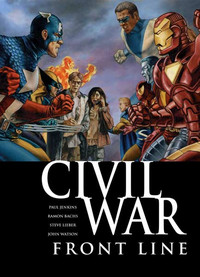 This is exactly what I was afraid of.
This is exactly what I was afraid of.
In setting up their big Civil War event, Marvel Comics is trying something unique: while the idea of government registration or regulation of superheroes isn’t a new one, framing the argument in such a way as to make it believable that large numbers of the heroes would actually join up is new.
The adventure hero, whatever his particular medium, is not a Corporate Man—he invariably stands for Freedom to one degree or another; even those (like policemen or FBI agents) who work in a structured environment are mavericks who inevitably get results by “going their own way.” And up to this point, Brian Bendis (in “The Illuminati”) and Mark Millar (in Chapter One of “Civil War”) have done a remarkably good job of setting up the pro-registration argument in a way that’s at least plausible for some of the heroes to accept. But writer Paul Jenkins has always been a “heart on his sleeve” type, and as I’d feared, in the new “Front Line” series, he seems unable (or unwilling) to apply the same even-handedness: Paul Jenkins has his “I’m With Captain America” banner proudly flying.
Front Line #1 is composed of three different stories: in the first, a miserably unhappy Ben Urich brings us up to speed on the developments that kicked off the Civil War, and his Daily Bugle colleague Sally Floyd receives a surprising late-night visit that illuminates how much is at stake in the conflict. We then find out that, as hinted in issue #1 of Civil War, one of the New Warriors did survive and just what that survivor faces now. Finally, in what has to be considered at least questionable taste, Jenkins parallels Spider-Man’s feelings about the Registration Act with the Japanese-American internment of World War 2.
I have always found Jenkins a maddening writer: he handles dialog and characterization brilliantly, and taken in bits and pieces he’s as impressive as any of the top writers working for the Big 2 today. But whatever his gifts in the small moments, he’s not a natural storyteller, tending to worry details to death, and putting off the answers to big questions for no other reason than to drag a story out. Even his Eisner-winning “Inhumans” series, for all its moments of brilliance, came down to the question “Why doesn’t Black Bolt DO something?!?” repeated over and over again; by the time we got to the last issue, ANY resolution was going to be anticlimactic (and “The Sentry” was much the same, in spades).
Here, Jenkins’ problem isn’t so much unanswered questions he’s going to drag on forever as political points he’s going to hammer home for 12 issues: in the first issue he’s already hitting us over the head with 9/11 and the Japanese internment, and made no bones about where he thinks the Superhero Registration Act falls on this continuum. In the main Civil War title, these political issues are subtext; for Jenkins, the whole notion of subtext seems alien. The only person outside of Tony Stark presented as completely supportive of the Act is a wholly demonized J. Jonah Jameson. The fact is, Paul Jenkins would be no more capable of writing about the restriction of civil liberty in any kind of evenhanded way than he would be of flying. And that’s particularly frustrating in light of the sensitivity with which he handles the various characters.
None of the artists for the three stories are given much to do besides illustrate talking heads, and both Ramon Bachs and Steve Lieber do what they can. Kei Kobayashi gets the Japanese-American internment story, and illustrates it lovingly, but the intermingling of Spider-Man into the tale, while inevitable, looks intrusive.
Don’t be misled by the cover, by the way, while it’s symbolically appropriate (Urich and Floyd standing between lines of opposing superheroes), it’s not to be taken literally: most of the characters pictured don’t appear in the story itself, and there’s very little action in the book at all.
Quite apart from any reservations I have about the stories, Marvel’s to be congratulated on a handsome package: three stories told in 32 pages, with no ads, for $2.99. Readers of Civil War who want something to keep their appetite whetted between issues of the main series, and who can accept the fact that Paul Jenkins long ago decided which side he’s on, may find it an interesting supplement. I’m not sure I’d give Jenkins’ scripts more than two Vikings, but the art, and the generous package, bump it up a notch for me.
RATING: 
Gaze into Frank’s Poetic Past in The Punisher: The Tyger #1
By
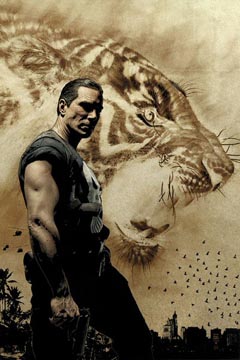 Tyger! Tyger! burning bright
Tyger! Tyger! burning bright
In the forests of the night,
What immortal hand or eye
Could frame thy fearful symmetry?
In what distant deeps or skies
Burnt the fire of thine eyes?
On what wings dare he aspire?
What the hand dare sieze the fire?
And what shoulder, & what art.
Could twist the sinews of thy heart?
And when thy heart began to beat,
What dread hand? & what dread feet?
What the hammer? what the chain?
In what furnace was thy brain?
What the anvil? what dread grasp
Dare its deadly terrors clasp?
When the stars threw down their spears,
And watered heaven with their tears,
Did he smile his work to see?
Did he who made the Lamb make thee?
Tyger! Tyger! burning bright
In the forests of the night,
What immortal hand or eye
Dare frame thy fearful symmetry?
William Blake 1794
In that most difficult of art forms, poetry, the careful crafting of language requiring not just knowledge, skill, thought, and emotion, but an indefinable touch of genius to rise above the mundane, there are few individual pieces that are both deep and popular. The Tyger is probably the best known great piece of poetry and forms the backbone of this origin tale of the Punisher. A poem that involves religion, philosophy, and nature is reflected by and included in this story that stretches from significant events from Frank Castle’s childhood to an early point in his career as the enemy of the Mob.
John Severin’s artwork is more than appropriate. Best known for his amazingly realistic western work in EC comics, the gritty human scale of his work reflects this only too human of Marvel’s heroes. With no superpowers, the Punisher is powered by that most super-invigorating of all emotions, hatred. Here there are lambs and tygers. Some are true lambs, meek and mild. Some are lambs that think they are tygers until they come face to face with the real thing, springing from ambush. Some are made by the Marines and God, through circumstances, into reluctant tygers. Eventually this combination creates the alpha tyger, a tyger among the tygers.
Many of the early issues of the Punisher do little justice to this unique character, but with the introduction of the Max series, the dirty actuality of what is required for such a man to exist and continue has been clearly revealed, and despite a few issues that strayed into international realms and unbelievable situations, here there is utter believability. Here there is also depth, layers of meaning and thought. It is not perfect but it is very good and not to be missed.
RATING: 
“Hero Squared” is all talk and no action, and I like it that way
By Graig Kent
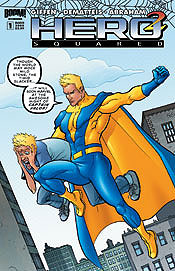 First a one-shot special, then a 3-issue mini, and now ongoing, and still the concept has me enamoured. Milo Stone, the book’s protagonist, is your prototypical slacker. He works in film (never really working at all), makes the least amount of effort with his girlfriend (and pretty much anything else), and has that sardonic attitude that suppresses any sense of awe, wonder and other such emotional reactions behind a protective cloud of negativity. His counterpart from another dimension, meanwhile, is a clean-cut, wistful, upbeat and, well, a superhero.
First a one-shot special, then a 3-issue mini, and now ongoing, and still the concept has me enamoured. Milo Stone, the book’s protagonist, is your prototypical slacker. He works in film (never really working at all), makes the least amount of effort with his girlfriend (and pretty much anything else), and has that sardonic attitude that suppresses any sense of awe, wonder and other such emotional reactions behind a protective cloud of negativity. His counterpart from another dimension, meanwhile, is a clean-cut, wistful, upbeat and, well, a superhero.
Earth in his own dimension is dead and the other Milo Stone, aka Captain Valor, had made his way into our dimension, turning the “normal” Milo’s world topsy-turvy. It only got worse when Valor’s arch-nemesis, the destroyer of his world called Caliginous, followed him. Caliginous kidnapped Milo, and exposed herself to him as the other-dimension version of his girlfriend, Stephie, and seduced him before sending him back to his everyday life.
This first ongoing issue deals with the repercussions of Milo’s weak-willed and immature nature, as well as delving into the past of Caliginous and Captain Valor. But more importantly, it examines the characters, really hitting home how different Valor and Milo are, and how similar Caliginous and Stephie might be.
There’s nothing that could really be described as “action” in Hero Squared, but amidst the talking heads, there’s lots of comedy, drama, and intensity. Though it might turn many muscles-n-tights fanboys off, it works, and it works damn well. If HBO were to make a superhero live-action show, it would probably wind up something like this. Keith Giffen and JM DeMattis have been doing this kind of dynamic character interaction for years, but they were rarely able to shed the costumes and just have complete characterization and story development through dialogue. The book runs 18 pages of heavy dialogue, with a 6-page dialogue-free cap that is one of those brilliant comic book moments. This sort of feels like what they’ve been building towards, a plainclothes relationship dramedy that has elements of the fantastic and supernatural.
While artist Joe Abraham may have been a little uneven previously, he’s got it all together here. I can imagine 24 pages of talking heads can get a little tedious to draw, but Abraham has become a master of facial expression and illustrative emoting, and the final pages are a showcase for his talent. I also love how he’s able to make alternate versions of both Milo and Stephie, giving them consistent physical traits and yet distinctive personalities.
I’m curious to see how the series progresses, but as a single issue, this is easily one of my favourites this year.
RATING: 
Another Month, Another Brilliant Issue of “Exterminators”
By Mark Wheaton
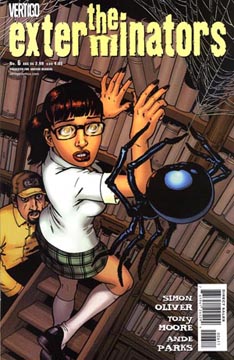 “This ‘reader’ is living out ‘Burroughs’s William Tell Act.’ After he accidentally shoots his wife, then he’s going to pretend to inject heroin and finish by fucking the young Mexican bell boy.”
“This ‘reader’ is living out ‘Burroughs’s William Tell Act.’ After he accidentally shoots his wife, then he’s going to pretend to inject heroin and finish by fucking the young Mexican bell boy.”
You think things were weird in issues #1-5? Just you wait, Henry Higgins, you old parlor room pervert.
As foreshadowed by the initial five-issue miniseries, the cockroach invasion has just begun – picking up right here in #6 with the beginning of the next arc entitled “Insurgency.” As the cockroach corpses are cleaned up in the apartment building devastated in issue #5, we catch sight of the golden scarab cockroach who is now threatening to return to the city’s general cockroach population to attack not from a single apartment building, but from the sewers – organizing millions of other roaches in revolt.
At the same time, Henry and Stretch get sent on their weirdest assignment yet – ridding a literary-themed fetish house of a black widow infestation that has taken over a mushroom in the “Lewis Carroll room.” They’re escorted around by a lovely librarian’s assistant – Page (a real dish, here’s hoping she becomes a love interest for the lesbianically cuckolded Henry) – who shows them some of the rooms, including the William S. Burroughs room mentioned in the initial quote.
When they hit the magnificently rendered, “The Prisoner”-esque Carroll room (kudos to artist Tony Moore), everything goes wrong – until Stretch comes up with a brilliantly “Silver Surfer”-inspired way of dispatching the vast number of deadly arachnids.
The rest of the issue continues to spill out – in small doses – the wide-ranging conspiracy behind the creation of the roach-mutating Draxx (yep, it involves the U.S. military and bio-weapons), but it doesn’t come across as hopelessly ridiculous as it might in another context, the effect likely to always be more interesting than the cause for this book’s writer.
As it hits the half-year mark, “The Exterminators” continues to be the best new comic of 2006. With gorgeous, crazy-ass art and consistent-as-all-hell writing, “The Exterminators” continues to surprise, intrigue, gross-out and thrill. And, with issue #6, makes a lot of readers wish there really was such a thing as a literary fetish bordello as illustrated within (though this reviewer knows he’d likely be relegated to the “Philip Roth” room).
RATING: 
Hard Time finishes its sentence early, giving you a look at what would have been
By Graig Kent
 The second “season” of Hard Time just didn’t stand a chance. The Steve Gerber/Brian Hurtt series launched two years ago as the only real standout from the failed “DC Focus” imprint, but the title was put on a lengthy hiatus after its twelfth issue, and when it re-emerged as “Season 2” without much promotional support, I knew the writing was on the wall. Hard Time, while a standout of one imprint, just sank into the background as part of DC’s lineup. The critics failed to notice it, and I’m even guilty of overlooking it on the stands a few times. I can’t help but think how the book would likely still be continuing on had DC shuffled it over to their Vertigo line, where, you would think, a prison drama about a teenager with the ability to astral project would fit in a little better.
The second “season” of Hard Time just didn’t stand a chance. The Steve Gerber/Brian Hurtt series launched two years ago as the only real standout from the failed “DC Focus” imprint, but the title was put on a lengthy hiatus after its twelfth issue, and when it re-emerged as “Season 2” without much promotional support, I knew the writing was on the wall. Hard Time, while a standout of one imprint, just sank into the background as part of DC’s lineup. The critics failed to notice it, and I’m even guilty of overlooking it on the stands a few times. I can’t help but think how the book would likely still be continuing on had DC shuffled it over to their Vertigo line, where, you would think, a prison drama about a teenager with the ability to astral project would fit in a little better.
The lack of respect the series received isn’t exactly new. We all have our favorite titles that were never marketed well and were cut short too early, leaving plot threads dangling, and our curiosity never satiated. Gerber, with Season Two writing partner Mary Skrenes, at the very least, get to close up the series with this seventh issue, dubbed “49 Years Later” (with a tacky spin on the “1 Year Later” bullet that adorn mainstream DC titles). In this issue, the book’s protagonist, Ethan Harrow, now in his sixties, is up for parole. Subjected to a futuristic examination process, he’s interrogated by the parole board, through which the writers detail the resolutions to all the major storylines they had introduced. As well they give a taste of all the storylines they had planned, which may have filled upwards of ten “seasons”, and the biggest disappointment is that we don’t get to watch the drama unfold (it’s like a soccer fanatic only getting to watch the highlight reel of the World Cup final).
Series artist Brian Hurtt, whom many still recognize from his Queen and Country work, wraps up the final issue with intriguing visual panache that reads more “giving his all” rather than “giving up”. It’s not hard to make a character look old, but a 50-years later Ethan amazingly looks like an aged version of the character, Hurtt’s master pen able to endow both wisdom and experience into him.
Even though it’s over, Hard Time remains a very different and wonderful series to discover.
RATING: 
![]()